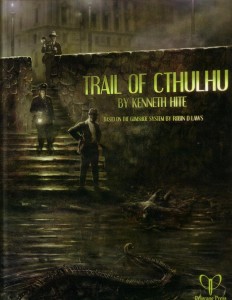Trail of Cthulhu
Pelgrane Press, $39.95
By Kenneth Hite
Reviewed by Matthew Pook
Call of Cthulhu is not perfect. It quantifies the Mythos, giving it numbers and making it knowable. Its skill system often results in the investigators not finding clues and thus stalling a scenario. It can be difficult to explain player character motivation for wanting to investigate the horrors of the Mythos.
Trail of Cthulhu is a licensed version of Call of Cthulhu from Pelgrane Press that addresses these issues. Written by Ken Hite (a member of the editorial board of The Unspeakable Oath), it uses that publisher’s GUMSHOE System, Robin D. Laws’ rules that shift the emphasis from finding clues to interpreting them. Hite adds Drives to explain investigator motivation. By discussing entities of the Mythos often in contradictory terms, not giving them stats beyond the Sanity loss they inflict, and by moving the game forward into the Desperate Decade of the 1930s, Hite makes Lovecraftian investigative horror unknown once again.
The first big difference between Call and Trail is that Trail asks which mode of play you prefer. It offers two, Purist or Pulp. Inspired by the majority of Lovecraft’s stories, the Purist mode has players and Keeper play out tales of intellectual and philosophical horror, doomed to a searing understanding of the cosmos. The Robert E. Howard-inspired Pulp mode is more physical, its protagonists ready with two guns blazing. The modes show in the Occupations: Author and Antiquarian are Purist while Alienist and Private Investigator are Pulp. In the Drives (investigator motivations), “Sense of Adventure” is Pulp, “Artistic Sensibility” is Purist. In the rules, Pulp mode allows Bullet Resistant Clothing and Purist mode calls for Ability caps.
Rather than traditional attributes and skills, in the GUMSHOE System characters are defined by two Ability types: Investigative (divided into Academic, Interpersonal, and Technical) and General. Both Ability types are represented by pools of points. Investigative Ability points are spent to acquire clues while General Ability points are spent to modify the die rolls in actions such as Driving, Fleeing, and Scuffling. Notably, both Health and Stability are General Abilities, as is the signature Sanity Ability, their points spent to save against taking physical or mental damage respectively.
While the use of point pools adds a resource management aspect, it shifts the focus to understanding clues rather than obtaining them, because Ability points are spent to gain extra information about a clue. If an investigator has an appropriate Ability, then he always gets the basic clue itself.
Alongside a re-examination of the Mythos, its entities, and its tomes, Hite provides a good overview of the 1930s, complete with new cults, some of which have a political aspect. In addition to the Brotherhood of the Yellow Sign and Yithian agents, he details Germany’s Ahnenerbe and Japan’s Black Dragon Society. Their inclusion nicely leads into the overview of the “Dirty Thirties,” a decade of famine, poverty, racism, totalitarianism (described as mankind’s own “Creeping Order”), and war.
Where in Call of Cthulhu an investigator simply loses Sanity, in Trail he can lose Sanity and Stability. Stability measures an investigator’s immediate mental state and can be relatively easily recovered, while Sanity measures acceptance of the universe’s true nature. Sanity is still lost for reading Mythos tomes, but is also lost for suffering a Mythos Shock (which occurs when a Mythos encounter drives an investigator’s Stability below 0), and, more radically, for using the Cthulhu Mythos skill to understand reality. Thus not only is learning Mythos knowledge dangerous, but so is using it, making it a more active decision than merely rolling the dice as in Call of Cthulhu. Similarly, casting spells in Trail is more dangerous, incurring a Stability check, a potential Mythos Shock, and potential health loss, so even for an insane sorcerer spells are still perilous.
Besides excellent advice for the Keeper on creating and running a Trail game, “Campaign Frames” offer alternative approaches and themes that could be pitched as television series. There are three samples. Project Covenant’s “The Untouchables meets Delta Green” or “The X-Files versus Fu Manchu!”, and Book-Hounds of London’s “It’s James Ellroy’s Ninth Gate,” are almost pitch perfect. The latter is currently being developed into an eponymous full-blown supplement.
Physically, Trail of Cthulhu is a well-presented book made all the better by the dark delight of Jérôme Huguenin’s photomontages that hint at something more. It’s arguably the best artwork to grace a Cthulhu book since Pagan Publishing’s The Realm of Shadows.
The publication of Trail of Cthulhu raises the question, “Why effectively rewrite Call of Cthulhu?” Well, the latter is almost 30 years old and for all its core elegance, its age shows. The presentation of stats for its Mythos menagerie is almost Dungeons & Dragons-like. And by modern gaming standards it fails to address fully the tasks of both players and Keeper. Both are issues that Hite has assuredly addressed in Trail of Cthulhu.
If ever there was a game writer spawned to author a Lovecraftian RPG, it is surely Kenneth Hite. Trail of Cthulhu is a harsher, grainier approach to Lovecraftian investigative horror. Fully supported by elegant mechanics, it opens up a whole new decade and restores the unknown of Lovecraft’s Mythos. Ten phobias.
But in some alternate universe, as you read this Sandy Petersen is working on a licensed version of Trail of Cthulhu, the classic horror RPG published back in 1981. He’ll title it Call of Cthulhu. . . .
This review appeared in The Eye of Light and Darkness in The Unspeakable Oath 18.
Reviewed items are rated on a scale of one to ten phobias:
1-3: Not worth purchasing.
4-6: An average item with notable flaws; at 6 it’s worth buying.
7-10: Degrees of excellence.


2 comments for “Trail of Cthulhu (Review)”